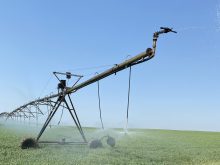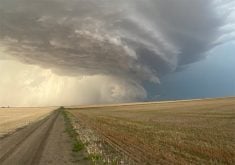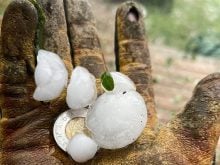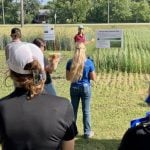CUSTER STATE PARK, S.D. – Wagon trains once regularly plied the trails of South Dakota bringing settlers, government surveyors, soldiers and their suppliers. A population increase during the last 25 years of the 1800s brought about the near extermination of 60 million bison that populated the North American plains.
A new wagon train came to southwestern South
Dakota last week. It was celebrating the 1,250 bison that roam Custer State Park and the half million head that graze the plains today.
The International Bison Conference takes place once every seven years. In the days before the 2007 convention began, the trek drew about 160 people to ride in wagons, ride horses and walk a 40 kilometre route through the bison’s range within the 71,000 acre park.
Read Also

Rented farmland jumps 3.4 million acres in Saskatchewan and Alberta
Farmland rented or leased in the two provinces went from 25.7 million acres in 2011 to 29.1 million in 2021, says Census of Agriculture data.
Temperatures in the mid 40s C, steep grades and downpours of rain were met hat-on by the participants during their four day trek from rolling prairie to rocky ravine. Covered in lodgepole pine and punctuated by marble and granite, the climb to hills higher than 2,100 metres created challenges for wagons, trekkers and riders.
“It’s a little early, this dawn thing. But where else would I get to wake up in a cloth tent and to the sound of horses and get out and walk 15 km through a place like this?” said 14-year-old Tannon Emerson. Along for the trek were his cousins, Reid Toews and Riley Emerson, and grandfather Bob Balisky, a bison producer from Debolt, Alta.
Emerson’s “place like this” is South Dakota’s Black Hills. The area was included in an 1874 scientific survey led by then Col. George Custer, who was killed in nearby Montana two years later.
The hills are home to Mount Rushmore’s four granite presidents, which attract many tourists. Thousands of motorcycle devotees come to nearby Sturgis each summer.
Most participants in the wagon train know the Custer herd by reputation, through the annual, late fall sale that markets the park’s bison crop to producers across North America.The buffalo were the main attraction for many taking part in the wagon train.
Pepe Seaford of West Knoyle, Wiltshire in the United Kingdom said the opportunity to ride in wagons and walk through the Black Hills was too great an opportunity for a British bison rancher to miss.
“My husband Colin and I are one of the few bison farms in Britain that commercially sell meat. He fell in love with bison watching a TV show about America or Canada and said, ‘he’d have a herd by the time he was 40.’
“We’ve been farming all our lives so we got some bison and, well, here we are, aren’t we? To see where they call home and sleep under these skies. We couldn’t miss that.”
The wagon train through the park was organized by Custer State Park’s bison manager, Chad Kremer, and the Dakota Territory Buffalo Association.
“It took us about two years to put this together. I’d have to say the look on people’s faces at times over the past four days has made this worth it,” said Kremer.
Daily moves of 30 canvas tents were handled by local boy scout troops and service agencies, after participants removed the 35 kilogram pine poles that supported them and did some folding.
Meals were catered by the nearby, historic State Game Lodge and included a different bison entrée each night.
James Atten of Montello, Wisconsin, walked and rode the trail using saddle and wagon.
“The heat … the rough riding trails, the early mornings. You forget all of that when you get to that evening meal of bison,” he said.
“The trail might be tough, but the bison sure isn’t,” he said, brandishing the plastic knife he used to cut his prime rib.














